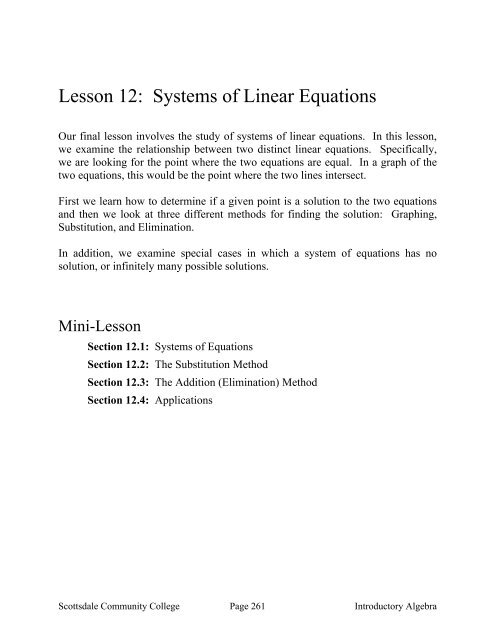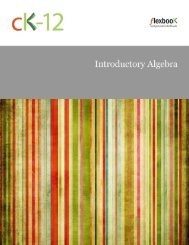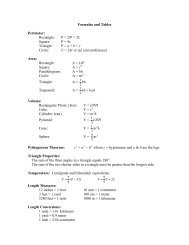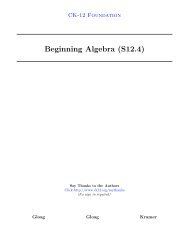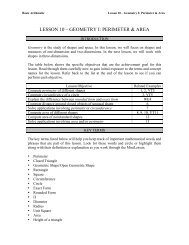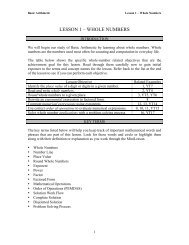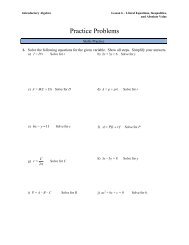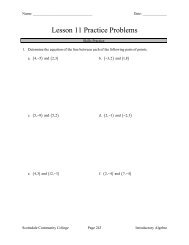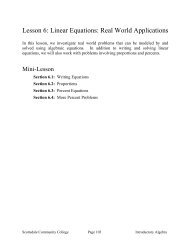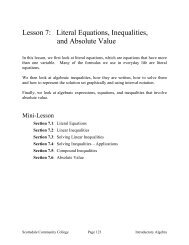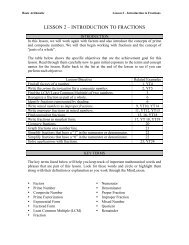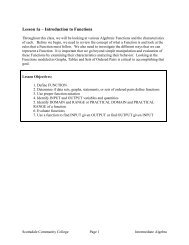Lesson 12: Systems of Linear Equations - Scottsdale Community ...
Lesson 12: Systems of Linear Equations - Scottsdale Community ...
Lesson 12: Systems of Linear Equations - Scottsdale Community ...
Create successful ePaper yourself
Turn your PDF publications into a flip-book with our unique Google optimized e-Paper software.
<strong>Lesson</strong> <strong>12</strong>: <strong>Systems</strong> <strong>of</strong> <strong>Linear</strong> <strong>Equations</strong><br />
Our final lesson involves the study <strong>of</strong> systems <strong>of</strong> linear equations. In this lesson,<br />
we examine the relationship between two distinct linear equations. Specifically,<br />
we are looking for the point where the two equations are equal. In a graph <strong>of</strong> the<br />
two equations, this would be the point where the two lines intersect.<br />
First we learn how to determine if a given point is a solution to the two equations<br />
and then we look at three different methods for finding the solution: Graphing,<br />
Substitution, and Elimination.<br />
In addition, we examine special cases in which a system <strong>of</strong> equations has no<br />
solution, or infinitely many possible solutions.<br />
Mini-<strong>Lesson</strong><br />
Section <strong>12</strong>.1: <strong>Systems</strong> <strong>of</strong> <strong>Equations</strong><br />
Section <strong>12</strong>.2: The Substitution Method<br />
Section <strong>12</strong>.3: The Addition (Elimination) Method<br />
Section <strong>12</strong>.4: Applications<br />
<strong>Scottsdale</strong> <strong>Community</strong> College Page 261 Introductory Algebra
<strong>Lesson</strong> <strong>12</strong> Checklist<br />
Component<br />
Required?<br />
Y or N<br />
Comments Due Score<br />
Mini-<strong>Lesson</strong><br />
Online<br />
Homework<br />
Online<br />
Quiz<br />
Online<br />
Test<br />
Practice<br />
Problems<br />
<strong>Lesson</strong><br />
Assessment<br />
<strong>Scottsdale</strong> <strong>Community</strong> College Page 262 Introductory Algebra
Name: ________________________________<br />
Date: _____________<br />
Mini-<strong>Lesson</strong> <strong>12</strong> <br />
Section <strong>12</strong>.1: <strong>Systems</strong> <strong>of</strong> <strong>Equations</strong><br />
Two linear equations that relate the same two variables are called a system <strong>of</strong> equations.<br />
The Solution to a System <strong>of</strong> <strong>Equations</strong><br />
The SOLUTION to a system <strong>of</strong> equations is the POINT at which the graphs intersect. This is the<br />
single ordered pair that is a solution to both equations.<br />
Types <strong>of</strong> Solutions to a <strong>Linear</strong> System <strong>of</strong> <strong>Equations</strong>:<br />
1. One unique solution: The lines intersect at exactly one point.<br />
2. No solution: The two lines are parallel and will never intersect.<br />
3. Infinitely many solutions: This occurs when both lines graph as the same line.<br />
Example 1: Verify that the point (5, 4) is a solution to the system <strong>of</strong> equations<br />
y = 2x−6<br />
y = x−1<br />
Solving a System <strong>of</strong> <strong>Linear</strong> <strong>Equations</strong> by Graphing<br />
Example 2: Solve the system <strong>of</strong> equations by graphing. Check your answer.<br />
2<br />
y = 6 − x<br />
3<br />
y = x + 1<br />
<strong>Scottsdale</strong> <strong>Community</strong> College Page 263 Introductory Algebra
<strong>Lesson</strong> <strong>12</strong>: <strong>Systems</strong> <strong>of</strong> <strong>Linear</strong> <strong>Equations</strong><br />
Mini-<strong>Lesson</strong><br />
Example 3: Solve the system <strong>of</strong> equations by graphing. Check your answer.<br />
4x ! 3y = !18<br />
2x + y = !4<br />
Example 4: Solve the system <strong>of</strong> equations by graphing. Check your answer.<br />
x ! 3y = 3<br />
3x ! 9y = !18<br />
<strong>Scottsdale</strong> <strong>Community</strong> College Page 264 Introductory Algebra
<strong>Lesson</strong> <strong>12</strong>: <strong>Systems</strong> <strong>of</strong> <strong>Linear</strong> <strong>Equations</strong><br />
Mini-<strong>Lesson</strong><br />
Example 5: Solve the system <strong>of</strong> equations by graphing. Check your answer.<br />
2x<br />
+ y = 3<br />
6x<br />
+ 3y<br />
= 9<br />
You Try<br />
1. Solve the system <strong>of</strong> equations by graphing. Check your answer.<br />
x− y = 2<br />
x+ y = 6<br />
Verify that your solution is correct:<br />
<strong>Scottsdale</strong> <strong>Community</strong> College Page 265 Introductory Algebra
<strong>Lesson</strong> <strong>12</strong>: <strong>Systems</strong> <strong>of</strong> <strong>Linear</strong> <strong>Equations</strong><br />
Mini-<strong>Lesson</strong><br />
<strong>Scottsdale</strong> <strong>Community</strong> College Page 266 Introductory Algebra
<strong>Lesson</strong> <strong>12</strong>: <strong>Systems</strong> <strong>of</strong> <strong>Linear</strong> <strong>Equations</strong><br />
Mini-<strong>Lesson</strong><br />
Section <strong>12</strong>.2: The Substitution Method<br />
Using Substitution to Solve a <strong>Linear</strong> System <strong>of</strong> <strong>Equations</strong><br />
Step 1: Solve one <strong>of</strong> the equations <strong>of</strong> the system for one <strong>of</strong> the variables.<br />
Step 2: Substitute the expression for the variable obtained in step 1 into the other equation.<br />
Step 3: Solve the equation.<br />
Step 4: Substitute the result back into one <strong>of</strong> the original equations to find the ordered pair<br />
solution.<br />
Step 5: Check your result by substituting your result into either one <strong>of</strong> the original equations.<br />
Example 1: Solve the system <strong>of</strong> equations using the Substitution Method.<br />
3x− 2y<br />
= 16<br />
2x+ y = 20<br />
Example 2: Solve the system <strong>of</strong> equations using the Substitution Method.<br />
5x− 4y<br />
= 9<br />
x− 2y<br />
=−3<br />
<strong>Scottsdale</strong> <strong>Community</strong> College Page 267 Introductory Algebra
<strong>Lesson</strong> <strong>12</strong>: <strong>Systems</strong> <strong>of</strong> <strong>Linear</strong> <strong>Equations</strong><br />
Mini-<strong>Lesson</strong><br />
Example 3: Solve the system <strong>of</strong> equations using the Substitution Method.<br />
3x + y = 5<br />
6x + 2y =11<br />
Example 4: Solve the system <strong>of</strong> equations using the Substitution Method.<br />
x ! y = !1<br />
y = x +1<br />
You Try<br />
2. Solve the system <strong>of</strong> equations using the Substitution Method. Check your answer.<br />
x ! 2y = !11<br />
5x + 2y = 5<br />
<strong>Scottsdale</strong> <strong>Community</strong> College Page 268 Introductory Algebra
<strong>Lesson</strong> <strong>12</strong>: <strong>Systems</strong> <strong>of</strong> <strong>Linear</strong> <strong>Equations</strong><br />
Mini-<strong>Lesson</strong><br />
Section <strong>12</strong>.3: The Addition (Elimination) Method<br />
Consider the following systems <strong>of</strong> equations.<br />
x− 2y<br />
=−11<br />
5x+ 2y<br />
= 5<br />
Using the Addition (Elimination) Method to Solve a <strong>Linear</strong> System <strong>of</strong> <strong>Equations</strong><br />
Step 1: “Line up” the variables.<br />
Step 2: Determine which variable you want to eliminate. Make those coefficients opposites.<br />
Step 3: Add straight down (one variable should “drop out”)<br />
Step 4: Solve resulting equation<br />
Step 5: Substitute this result into either <strong>of</strong> the ORIGINAL equations<br />
Step 6: Solve for the variable<br />
Step 7: CHECK!!!!!!! Plug solution into BOTH equations!<br />
Example 1: Solve the system <strong>of</strong> equations using the Addition (Elimination) Method.<br />
4x− 3y<br />
=−15<br />
x+ 5y<br />
= 2<br />
<strong>Scottsdale</strong> <strong>Community</strong> College Page 269 Introductory Algebra
<strong>Lesson</strong> <strong>12</strong>: <strong>Systems</strong> <strong>of</strong> <strong>Linear</strong> <strong>Equations</strong><br />
Mini-<strong>Lesson</strong><br />
Example 2: Solve the system <strong>of</strong> equations using the Addition (Elimination) Method.<br />
3x− 2y<br />
=−<strong>12</strong><br />
5x− 8y<br />
= 8<br />
Example 3: Solve the system <strong>of</strong> equations using the Addition (Elimination) Method.<br />
7x− 2y<br />
= 41<br />
3x− 5y<br />
= 1<br />
You Try<br />
3. Solve the system <strong>of</strong> equations using the Addition (Elimination) Method.<br />
Check your answer.<br />
2x+ 3y<br />
= 18<br />
x− y = 4<br />
<strong>Scottsdale</strong> <strong>Community</strong> College Page 270 Introductory Algebra
<strong>Lesson</strong> <strong>12</strong>: <strong>Systems</strong> <strong>of</strong> <strong>Linear</strong> <strong>Equations</strong><br />
Mini-<strong>Lesson</strong><br />
Section <strong>12</strong>.4: Applications<br />
Example 1: Movie tickets cost $7 for adults (matinee), $5.50 for children. There are 218<br />
seats in the theater. A total <strong>of</strong> $1,463 was collected in ticket sales for the sold-out Saturday<br />
matinee. How many adults and how many children were in the theater?<br />
a. Write an equation representing the total number <strong>of</strong> tickets sold.<br />
b. Write an equation representing the total amount <strong>of</strong> money collected from the sale <strong>of</strong> all<br />
tickets.<br />
c. Solve this system <strong>of</strong> linear equations.<br />
<strong>Scottsdale</strong> <strong>Community</strong> College Page 271 Introductory Algebra
<strong>Lesson</strong> <strong>12</strong>: <strong>Systems</strong> <strong>of</strong> <strong>Linear</strong> <strong>Equations</strong><br />
Mini-<strong>Lesson</strong><br />
You Try<br />
4. Tickets to a 3D movie cost $<strong>12</strong>.50 for adults and $8.50 for children. The theater can seat up<br />
to 180 people. A total <strong>of</strong> $1,826 was collected in ticket sales for the sold-out 7:15PM show.<br />
Determine the number <strong>of</strong> adult tickets and the number <strong>of</strong> children’s tickets that were sold.<br />
a. Write an equation representing the total number <strong>of</strong> tickets sold. Clearly indicate what<br />
each variable represents.<br />
b. Write an equation representing the total amount <strong>of</strong> money collected from the sale <strong>of</strong> all<br />
tickets.<br />
c. Solve this system <strong>of</strong> linear equations.<br />
Number <strong>of</strong> adult tickets sold: ______________<br />
Number <strong>of</strong> children’s tickets sold: _____________<br />
<strong>Scottsdale</strong> <strong>Community</strong> College Page 272 Introductory Algebra


